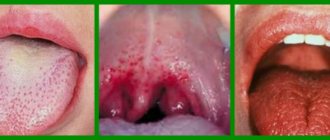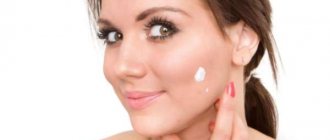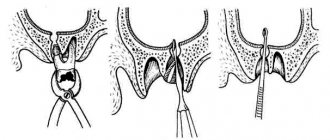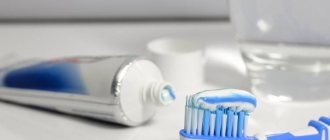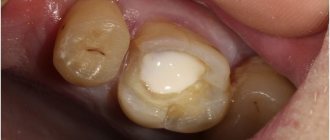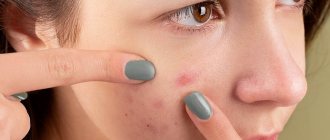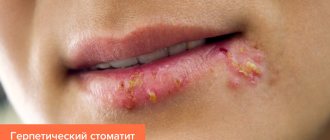Causes of facial allergies
Atypical reactions of the immune system to foods, chemicals and biological substances can cause rashes, pimples, redness, swelling and itching. The person experiences physical and moral discomfort. The manifestations of allergic reactions are varied and depend on the individual characteristics of the body. Most often, localization is observed on the forehead, temples, cheeks, behind the ears, in the décolleté area and on the neck. The most common prerequisites for allergies are:
- heredity;
- consequences of long-term use of medications;
- unfavorable environment;
- constant stress;
- reduced immunity;
- too high a concentration of certain substances;
- insect bites;
- cold or direct sunlight.
There may be other reasons; you need to approach the problem individually.
Allergies to foods and medications
There is often cross-reaction to the protein in this group, making it difficult to find the source. The speed of onset of symptoms can vary from immediate to a period of 2-3 hours. In the case of medications, the prerequisite is overdose, long-term use, too many drugs taken during the day.
Sun or cold
The body’s response is characteristic not only of winter. This could be water or food at a certain temperature. The appearance of photodermatitis is promoted by internal and external causes. Within a day or a little later after exposure to the sun, soreness and itching of the skin begin to bother. When an allergic rash appears on the face of an adult, treatment should begin immediately, otherwise the situation will worsen with each passing hour. As part of complex therapy, immunostimulating cosmetics such as Laennec are effective. Before use, you should consult with specialists.
Reaction due to eczema
Skin diseases significantly reduce the body's resistance, and any violation provokes their exacerbation. Most often, the reaction appears externally in the form of small bubbles with liquid. The acute form can become chronic, which subsequently leads to relapses.
Errors in diet
Various dietary restrictions do not go out of fashion. There are programs based on the consumption of one or just a few products for a long time, which leads to an oversaturation of the body with certain elements, since in this case there can be no talk of balance. You should not be surprised at the deterioration in well-being, since such restrictions become the causes of severe allergies on the face of an adult, the treatment of which is carried out comprehensively and will take a lot of time.
We recommend
GHC Placental 3D Mask withQ10
Serum concentrate
Repairing cream with a moisturizing effect
Placental antioxidant lotion concentrate
Contact with animals, insect bites
A swollen nose and watery eyes when trying to pet a pet are a true classic of the genre. Mosquitoes, bedbugs and other blood-sucking creatures can also cause itching and redness on the skin. The toxins they inject in large quantities cause a rash, often accompanied by fever. In this case, external agents and antihistamines are recommended; dosages should be confirmed with a doctor.
Allergies due to stress
In addition to nervous tics, there are other reactions to emotional overload. Unconsciously, a person may scratch or clench their hands tightly. If such situations happen regularly, then health problems may begin. Itching, swelling of certain areas, redness, and difficulty breathing appear. The main direction of stabilizing the condition is the prescription of sedatives, breathing exercises aimed at calming the nervous system, ointments and gels to relieve external manifestations on the skin.
Why did pustules appear on the face?
Pimples with purulent contents form against the background of a decrease in the protective function of the epidermal barrier.56
Internal causes that can cause the appearance of pimples* and pustules on the face are56:
- temperature irritants;
- skin contamination;
- dryness of the epidermis;
- exposure to aggressive chemicals, etc.
Endogenous causes include56:
- overwork;
- poor nutrition;
- diseases of the digestive system;
- chronic intoxication;
- reduced immunity;
- endocrine disorders.
Weakening of the antibacterial protection of the skin may be associated with autoimmune diseases and diabetes.
Types of allergies on the face
If in children the most vulnerable area is the buttocks, where signs appear that indicate certain foods or unfavorable conditions, then in adults this is the nasolabial triangle, eyelids, lips, tongue, neck and hands.
Atopic dermatitis
Chronic inflammatory skin disease. Most often begins in early childhood. The priority prerequisite is genetic predisposition. It can be a concomitant disorder with bronchial asthma and conjunctivitis. There are infant, child and adult forms of the disease.
Hives
Allergies and rashes in the form of pimples on the face, the photo of which most often appears on advertising posters of the newest antihistamines, occurs with a seasonal variant. It is characterized by lacrimation, swelling of the eyelids, obsessive itching, and redness of certain areas of the body.
Food reactions can occur instantly when certain foods enter the mouth and esophagus. Most often they are milk, eggs, red or yellow fruits, and nuts. Peanuts are the most dangerous in this regard.
Contact dermatitis
Recognizable by clear zones of irritation. The causes are hygiene and cosmetic products, chemicals that come into contact with unprotected skin, jewelry, piercings, latex products, extracts and juices of certain plants. It manifests itself in the form of weeping erosions, in place of which dry scales then appear. To understand how to remove facial allergies, you need to find and eliminate the substance that causes your health to worsen. Often a good result comes from moving to another region. This way, it is possible to cut off some of the options; for the rest, you will have to take special tests in the laboratory.
Toxicoderma
A distinctive point is inflammation not due to external factors, but due to the penetration of a provoking substance into the body. In some cases, it can cause secondary damage to internal organs and anaphylactic shock, since it develops rapidly from the ingestion of an allergen from the inside. One way to prevent inflammation is to take antibiotics, especially penicillin. At the same time, timely treatment gives good results.
The alimentary variety is included in a special group; the deterioration of the condition is provoked not by products, but by food additives in their composition. It is quite dangerous due to the fact that it can occur suddenly, since manufacturers do not indicate all the ingredients in the composition.
Quincke's edema
It poses a direct threat to life. In the question of what an allergy on the face and neck looks like in this case, what to do and how to treat it, time is of the essence. Choking occurs quickly, and the slightest delay can have fatal consequences. An acute inflammatory reaction of the body, which occurs locally in the skin and subcutaneous tissue, affects deep layers, including the muscles of the respiratory system, and in a third of cases is localized in the larynx. It is impossible to prevent the development of Quincke's edema. Women suffer from this disorder more often. The diagnosis is made based on the clinical picture and requires medical attention. Signs may persist for several days and disappear gradually. Treatment includes the administration of potent antiallergic drugs. In severe cases, the patient requires urgent hospitalization in an intensive care unit or intensive care unit.
Pustules on the face: what to do?
Since pustules indicate an inflammatory process, most cosmetic procedures are contraindicated for them. What remains is drug treatment and home care. Here are some guidelines to follow:
- Gentle care. If there are an abundance of pustules, it is necessary to take more careful care of the skin so as not to damage them. It is necessary to discard the idea of squeezing out acne elements. This is fraught with the spread of inflammation and aggravation of the clinical picture.
- Exclusion of alcohol-containing products from care. Attempting to dry acne will not be beneficial. The skin will respond with even greater sebum production and hyperkeratinization. And these are already two links in the mechanism of acne formation.
- Nutrition correction. Since the appearance of acne may be associated with the consumption of certain products, for example, dairy. There is evidence that if there is an excess of sugar and fat in the diet, as well as eating on the go, it can provoke an exacerbation of acne.60
- Light makeup. Pustular rashes are very difficult to hide with cosmetics. As a rule, applying a generous amount of foundation creates a mask effect. The face looks unnatural and the skin cannot breathe. As a result, the pores only become more clogged. Makeup for acne is acceptable, but it is better to keep it light. In the evening, it must be carefully removed, for example, with micellar water or milk.
- Refusal of traditional methods of treatment. Do not try to prepare masks or creams yourself. Firstly, the use of multi-component compositions prepared by yourself can provoke irritation, itching, redness, and an allergic reaction. Secondly, you will waste time and may make the problem worse.
You can get rid of pustular rashes only by using medications prescribed by a dermatologist.
What does an allergy look like on the face?
There are many manifestations of allergies, and they depend on the form, location and intensity. The main indicator of the disorder is sudden swelling of the eyes and lips, one or both. Changes also affect the structure of the skin. It becomes lumpy, swollen, with a small scattering of small dots. Red, uneven spots of varying sizes often appear. Cracks and a scaly structure may be observed. If you give in to temptation and start scratching the itchy areas, the condition will quickly worsen.
Depending on the type of disorder and the affected area, allergic rashes on the face are likely, the treatment of which requires an integrated approach. Along with pharmaceutical drugs, cosmetics have a fairly good effect. Plasma therapy with the Japanese drug CURACEN perfectly restores appearance, but only after the acute period ends and the condition stabilizes.
Types and stages of post-acne
Among the main signs of post-acne, hyperpigmentation is identified - these are areas of normally colored and darker skin, alternating with each other and forming an uneven tone.
In addition, the typical presence of stagnant red spots, enlarged skin pores, often filled with sebum, as well as pathological scars. In the area of blockage of the sebaceous glands, atheromas (sebaceous gland cysts filled with fatty secretions) or milia (whiteheads) are formed.
The main sign of post-acne is old cicatricial changes, scars after healed purulent acne. They can take three forms:
- depressed areas of skin, dimples (or atrophic scars);
- convex, lumpy areas, often with areas of erythema (hypertrophic);
- areas of dyschromia (the surface of the skin is spotty, with areas of increased pigmentation).
Sometimes the formation of keloid scars is mistakenly added to the classification. This is the wrong approach. People with a hereditary predisposition to the formation of rough and poorly healing scars that disfigure the appearance do not often suffer from acne, and therefore post-acne phenomena are rare for them.
The most common type of post-acne is the appearance of atrophic scars. According to the Jacob CI classification, they can take the form of rounded, chipped and square elements. This division helps doctors plan treatment and predict its results.
Round scars are the shallowest, and the prognosis for them is the most favorable. The square ones are somewhat deeper, but are also eliminated quite well. The biggest problem is the chipped forms of post-acne, they look like the Latin letter “V”, their bottom is located deep in the dermis.
Types of skin damage from acne
How to diagnose allergies
The main difficulty is to distinguish it from a skin disease. Rashes should not be a reason for panic, but a prerequisite for examination. To prevent exacerbation and speed up the process of identifying causes, it is necessary:
- try to independently identify the allergen by eliminating cosmetics or products from everyday use, doing this gradually in order to replace the changes in time;
- take an antihistamine that has already been used as prescribed by a doctor;
- Remove all alcohol-based external care products from use.
After such measures, it will be much easier to determine how to relieve an allergic reaction on the face and alleviate the general condition.
We recommend
GHC Placental 3D Mask withQ10
Serum concentrate
Repairing cream with a moisturizing effect
Placental antioxidant lotion concentrate
Treatment of seborrheic dermatitis in adults and children
Seborrheic dermatitis may resolve without treatment. But it often occurs in waves, with remissions and exacerbations.
Several repeated courses of therapy or ongoing maintenance therapy may be required until the symptoms go away completely. After some time, exacerbation may occur again.
You should consult a doctor if repeating the usual regimens of care and relieving acute symptoms does not help, as well as if there are signs of a secondary infection.
The basis of therapy is the use of medicinal shampoos, creams and lotions.
For children, it is recommended to use special children's shampoos; before washing, you can apply oil or cream to help soften the crusts.
In children, it is important to stop itching, since scratching can cause secondary infection of the scabs.
Features of the treatment method
When selecting external skin care products, choose products containing the following ingredients that reduce skin inflammation:
- Keratolytics: salicylic, lactic acid, urea, propylene glycol.
- Topical antifungal agents: shampoos and creams containing ketoconazole (ciclopirox).
- Products with selenium disulfide or zinc pyrithione.
- Local low-strength corticosteroids can only be used as prescribed by a doctor to relieve the acute phase of the disease, except for the facial skin.
- In case of resistant forms, patients may be offered oral antifungal drugs.
- In severe cases, isotretinoin or phototherapy may be considered.
How is seborrheic dermatitis treated at the Rassvet clinic?
We evaluate the patient's skin type, severity and location of the rash.
The diagnosis of seborrheic dermatitis is based on the clinical picture. The detection of Malacesia has no diagnostic value, since this is a normal microflora of human skin.
A dermatologist evaluates the condition and makes a differential diagnosis with psoriasis, rosacea (on the face), pityriasis versicolor (on the body), and atopic eczema in children. At first, we usually recommend shampoo and only if the selection of permanent skin care products fails, do we move on to active drug therapy.
Treatment
It is not recommended to use drugs other than antihistamines on your own. In most cases, they are enough to eliminate the main symptoms and relieve swelling. It is necessary to take into account that the action must be comprehensive and must include creams, ointments and gels to relieve external signs of the disease.
Preparations for internal use
Medicines prescribed by a doctor are divided into corticosteroid and non-hormonal. The first are produced on a hormonal basis, have a powerful effect, but have a number of serious contraindications for long-term use. The second, milder ones, are prescribed to relieve mild forms of irritation. Several generations of antihistamines are available in pharmacies. If the former, such as Suprastin, influenced the level of attention, causing drowsiness and inhibition of reactions, then Cetrin, Telfast, Claritin, with high efficiency, do not give side effects that could become a limitation for work in areas where concentration is required.
Cosmeceuticals and their help in the fight against allergies
When the body reacts violently to a stimulus, skin lesions are sure to appear, and sometimes quite unpleasant ones. These are not only rashes and pimples, but also increased dryness and microcracks. Their danger lies in the possible entry of bacteria and the development of local inflammation. The main task, along with eliminating illness, is strengthening the immune system. Cosmetic products from the medical corporation "RHANA" are used in professional problem solving, provide a quick and lasting positive effect, allowing you to maintain beauty, health and prevent premature aging. And the skin is susceptible to it if an allergic reaction often appears on the face, a photo of which clearly demonstrates the degree of damage to the integument.
In order to give a fresh look and ensure cellular renewal, it is recommended to use placental preparations:
- Modeling mask with placenta hydrolyzate GHC Placental 3D Mask withQ10. It will prevent the risk of developing inflammation and give a healthy tone.
- Concentrate serum for intensive revitalization GHC Essence will instantly restore inner radiance, and also improve microcirculation and cell nutrition.
- LNC Repairing Cream with a moisturizing effect will preserve the beauty and freshness of the skin, and also protect it from moisture loss and eliminate the regeneration of ceramides (epidermal cells).
- Placental antioxidant lotion concentrate LNC Toning Lotion will protect cells, normalize melanin production and provide optimal hydration.
The dangers of self-medication
According to preliminary forecasts, the number of people reacting to certain stimuli will reach almost 90% by the end of the century. Allergists-immunologists mention the fault of allergy sufferers themselves, who, by self-medicating, expand the range of allergens and provoke the development of other diseases. In this case, the part is fixed and passed on by inheritance. By identifying the cause and drawing up an optimal treatment regimen, you can almost completely eliminate the likelihood of regular exacerbation of allergies.
Ringworm “as a keepsake”: the most common skin problems after COVID-19 are named
Source: "DoctorPeter" Date: 07/23/2021
Hair loss and skin rashes are common complaints among those who have recovered from COVID-19. As the City Committee for Internal Affairs said, doctors have not yet identified exclusively “Covid” skin problems - many of them also arise with other diseases.
Related to COVID-19, but not certain
According to Elena Moshkova, dermatologist of the City Clinical Infectious Diseases Department, no special skin rash characteristic only of coronavirus infection has yet been identified.
— Taking into account the still short period of observation of patients with COVID-19 and skin manifestations, it cannot be stated unequivocally that there are pathognomonic skin rashes (unambiguously describing a specific disease - editor's note), and they can be used to confirm infection with the new virus. Quite the contrary. The patient knows that he has a history of coronavirus infection, and the doctor can conclude that these skin manifestations are most likely associated with a viral disease, Elena Moshkova told Doctor Peter.
The doctor named the 5 most common skin complications after Covid with which patients come to the City Clinical Hospital.
Pink lichen of Zhiber
It appears as round, scaly spots usually up to 2 cm in diameter. Over time, the central part of the spot fades, but the edges remain quite bright. Patients may experience itching, but not always - this is individual. According to Elena Moshkova, Zhiber’s pityriasis rosea can occur not only after Covid, but also against the background of a common ARVI, and in other situations when immunity is reduced.
“It is important that this dermatosis is not contagious and for most it can go away within a few weeks even without treatment. Such patients rarely require the use of glucocorticosteroid creams and systemic therapy, the dermatologist said.
Skin vasculitis
Another common problem.
Skin vasculitis is characterized by hemorrhagic spots, which fade over time like small bruises. Some people, most often older people, may develop areas of necrosis - dead cells - on the skin. — The coronavirus that causes COVID-19 is tropen (prefers - editor's note) to vascular receptors. Therefore, it is not surprising that skin vessels can also be affected, often on the hands and feet. However, the diagnosis of “vasculitis” existed in dermatology even before Covid, the doctor adds.
Rashes
Toxic-allergic rashes also occur in those who have recovered from the disease . However, according to Elena Moshkova, in most patients with such problems, doctors cannot determine for sure whether this is a consequence of COVID-19 or a reaction to taking medications in the treatment of a viral disease.
In addition, those with a high fever may suffer from common heat rash - this often goes away on its own, but in some cases special medications may be required to reduce the itching. After a coronavirus infection, doctors also observe urticaria-type , usually on the skin of the palms. According to Elena Moshkova, if you have urticaria, you still need to go to the doctor - he will conduct a differential diagnosis, because it can be confused with a variant of skin vasculitis.
Rare, but without bald spots
Those who have recovered from Covid go to the City Clinical Internal Affairs Department not only with rashes and spots on the skin. Both men and women are often worried about another post-Covid problem - hair loss, as “Doctor Peter” has written about more than once. Hair does not begin to fall out immediately, but only several months after the illness. As doctors specify, the hairline thins, but bald spots do not form.
— The main reason is impaired blood circulation in the scalp due to damage to the vascular walls. Plus, stress, concomitant intoxication, and drug therapy for the disease contribute to this. And under unfavorable conditions, the alternation of phases of activity and rest of the hair follicles is disrupted. This happens regardless of the severity of Covid - everything is individual,” explains Elena Moshkova.
According to the doctor, usually over time, blood supply to the scalp is restored and hair density returns to normal. Good nutrition also helps speed up the solution. However, consulting a trichologist in this situation may not be superfluous, especially if the problem is too noticeable.
* Nadezhda Krylova
Preventive measures
In order not to look with disappointment at your reflection in the mirror and not to wonder how to get rid of allergies on your face once again, you should listen to the simple but effective advice of specialists.
- Adjust the daily menu by removing from the diet foods that provoke the appearance of characteristic symptoms of an immune disorder.
- Do not use cosmetics based on alcohol and other aggressive substances, giving preference to soft and neutral ones.
- Do not stay in the sun for a long time, and in winter, protect your skin from the cold as much as possible.
- During seasonal exacerbations of hay fever, use inhaled isotonic saline solutions to reduce the concentration of pollen in the nasopharynx.
- Always keep in your medicine cabinet an antihistamine recommended by an allergist-immunologist.
It is worth remembering that angioedema alone cannot be prevented. Other types of allergies are completely preventable, and this is much more effective than constantly treating exacerbations. Immunity support should take the leading place in the list of mandatory activities.
Symptoms
Seborrheic dermatitis is manifested by redness, peeling with “oily” scales with a certain localization of foci.
In children - isolated on the scalp (in the frontal area it is called the “baby cap” or “milk crust”), behind the ears and in the external auditory canal, on the face (in the area of the eyebrows, wings of the nose), on the back of the neck (along the edge of hair growth), in areas of skin friction (in folds), under diapers.
Sometimes seborrheic dermatitis in children is widespread. These are rashes in the form of spots with greasy crusts, merging into larger areas. In some cases it is accompanied by itching.
In adults, seborrheic dermatitis is presented in the scalp area, on the face: in the area of the eyebrows, behind the ears, inside the ears, on the wings of the nose and in the areas of the cheeks adjacent to the nose.
It can manifest itself as separate spots with peeling, total damage to the scalp, damage to the eyelids in the form of blepharitis, damage to the chest wall in the form of individual nodules and spots with crusts on the surface, inflammation of the hair follicles on the skin of the upper half of the body (ostiofolliculitis).
Why are allergies on the face dangerous?
A scattering of small specks or red spots not only look unsightly, but also pose a hidden threat. Acute inflammation, accompanied by swelling, can spread to the neck and make breathing difficult.
Violation of the structure of the skin, accompanied by a feeling of tightness, reduces the natural resistance to external influences. Weeping areas, as well as cracks in the upper layer of the epidermis, create a favorable environment for the proliferation of pathogenic bacteria, which leads to the appearance of pimples and ulcers. When such a condition occurs and is not treated, there is a high probability of it becoming chronic. In addition, an unpresentable appearance can cause a sensitive blow to pride and cause problems in communication.
If an allergic rash appears on the face, a specialist from a clinic or health center will tell you how to treat it. It is better to contact him at the first signs in order to make a timely diagnosis and receive an effective treatment regimen to avoid complications.
Ways to get rid of post-acne
The intensity of post-acne is directly related to the severity of acne. Therefore, it is important to work not only to eliminate the consequences, but also to prevent the appearance of new elements on the skin. It is necessary to fight acne itself, eliminating its main causes. If pimples appear again and again, the prognosis for post-acne treatment is questionable; inflammation will give rise to new scars. Therefore, work with an experienced dermatologist-cosmetologist is required.
Most of the work on restoring, smoothing the skin and eliminating scars is carried out by a cosmetologist, but certain activities can also be performed at home. Moreover, only an integrated approach will give the most maximum results.
What can you do at home?
At home, you need to help the skin recover; it needs building elements and proper nutrition. To regenerate the skin and form its structure, it is necessary to supply vitamins and minerals, protein as a source of amino acids for the construction of collagen fibers and the synthesis of hyaluronic acid, which moisturizes and gives the skin tone and smoothness.
In addition, omega acids are important, which are involved in cell renewal and form cell membranes. It is important to adjust your diet, eliminate as much processed foods as possible, food chemicals (dyes, preservatives, E-additives) and give up bad habits.
To prevent new acne and improve tone, nourish the skin, heal inflammation and small scars, pharmaceutical products will help. You can use 1% salicylic alcohol or boric acid and wipe the skin with it twice a day. Levomekol ointment works quite well in treating acne, suppressing inflammation and eliminating scars. Many people use bodyaga powder, which is diluted in water to a paste and applied to the affected area. But before using all these remedies, it is important to first consult with your doctor to prevent side effects and complications.
Skin care is complemented by serums, care creams (day and night) selected by a cosmetologist, as well as homemade peelings with fruit acids. They delicately exfoliate the skin, remove dead cells, and cleanse its surface.
Folk remedies are often used, for example, infusions of St. John's wort and chamomile, which have an anti-inflammatory, soothing, cleansing effect. You can freeze them and wipe the skin with the resulting ice cubes, further increasing blood circulation and capillary tone.
You can also use masks with blue clay. The recipe for making a mask is very simple: three tablespoons of powder are diluted in water to a paste, applied to the problem area for 20 minutes and then thoroughly washed off with water.
What treatment methods are used in a cosmetology clinic?
Although homemade recipes help in the fight against post-acne, you should not think that only through them you can eliminate all problems. Home methods act on the very top layers of the skin and reduce only minor defects.
Modern cosmetic procedures will help get rid of deep scars, pigmentation and unevenness. But don't expect instant results.
Treatment methods are selected individually and comprehensively. The more severe the initial problem and the wider the affected area, the longer the treatment will be.
To achieve maximum smoothness of the skin and an even complexion or eliminate blemishes on the body, you need a whole series of procedures, supplemented by home care and carefully selected cosmetics. On average, the first noticeable results will be visible after 1-2 months with regular implementation of all necessary treatment measures.
If there is unevenness, decreased skin tone, pigmented or stagnant spots, peelings . There are a lot of treatment options: these can be mechanical peels (compositions with herbs, small dense particles) and chemical peels (with retinol, glycolic, resorcinol or other compounds).
With mechanical peeling, the effect of cleansing and exfoliation is achieved due to the mechanical scraping of the particles included in the composition of the upper layer of skin with outdated epithelial cells.
With chemical peeling, a similar effect is achieved through chemical cauterization of the upper layer of the epidermis, which leads to its subsequent rejection with peeling.
The cosmetologist selects peelings to suit your needs and strictly follows all the rules for their implementation in order to achieve maximum effect and avoid side effects. On average, the first results are visible after 5-6 procedures.
A more effective analogue of peeling is laser skin resurfacing . The doctor performs the procedure with a special laser unit with a strictly specified wavelength in order to influence the skin at the required depth without damaging neighboring tissues. The laser beam cauterizes the skin, the treated areas are actively exfoliated, which allows stimulating the regeneration of new tissues, more even and smooth.
Check out our patient's review of laser facial resurfacing:
Photothermolysis is a more advanced method of laser skin treatment. The rays do not act as a continuous field, but as individual points - creating a mesh on the treated area. This is a fairly effective, but less traumatic effect; the rehabilitation period after such procedures is reduced.
dermabrasion is used to combat skin imperfections . This is the use of aluminum oxide powder under pressure or a special rotating abrasive disc for mechanical grinding of the skin, removing the upper layers of the epidermis from it.
Filler injections can help eliminate atrophic scars and dimples and smooth out the skin . They are inserted under the defect area, create additional volume, and lift depressed skin. The effect lasts up to 6-10 months (depending on the drug), then the injections are repeated.
Mesotherapy with drugs that stimulate collagen synthesis and epidermal renewal gives good results A series of microinjections are made into the surface layers of the skin with the introduction of hyaluronic acid, antioxidants, and vitamin components. The cosmetologist selects a specific drug depending on the tasks and the severity of skin defects.
Another method is ozone therapy . This is a technique of introducing a special oxygen mixture into a problem area through a series of microinjections. The composition helps saturate tissues with oxygen, stimulates blood circulation or lymph drainage, and epithelial regeneration.
If no other methods have produced a significant effect, surgical removal of scars can be used. The affected scar tissue is excised within the boundaries of healthy skin. The rehabilitation process is long, and the intervention itself can also leave scars in the future.
Post-acne treatment at Dr. Gruzdev’s clinic:
Chemical peeling The clinic offers gentle superficial peels: almond and glycolic.
More details
Laser resurfacing Impact of a laser beam on problem areas of the surface layer of the dermis.
More details
Biorevitalization A non-surgical technique for facial rejuvenation using preparations based on hyaluronic acid.
More details
Mesotherapy An injection technique for introducing “cocktails” into the skin based on vitamins, microelements, and amino acids.
More details
Prevention of seborrheic dermatitis on the face
To prevent dermatitis on the forehead from causing a relapse, it is recommended to follow several rules:
- strengthen the immune system;
- cleanse the body of waste and toxins;
- exclude from the diet salty and spicy foods, fatty and smoked foods, marinades, spices and condiments, sweets, chips and crackers, products containing preservatives, flavor enhancers and dyes;
- introduce fermented milk products into the menu, which include lacto- and bifidobacteria, animal proteins, bran, buckwheat, oatmeal;
- cook food with vegetable oil;
- restore the functioning of the digestive system.



